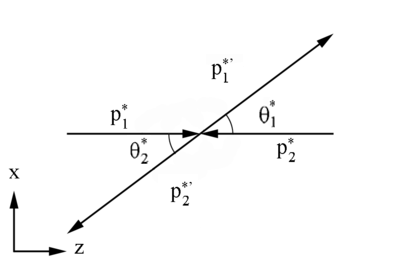|
|
| Line 38: |
Line 38: |
| | | | |
| | <center><math>s \equiv 2m^2+2(E_1^{*2}+\vec p_1^{*2} )</math></center> | | <center><math>s \equiv 2m^2+2(E_1^{*2}+\vec p_1^{*2} )</math></center> |
| | + | |
| | + | |
| | + | Using the relativistic energy equation |
| | + | |
| | + | <center><math>E^2 \equiv p^2+m^2</math></center> |
| | + | |
| | + | |
| | + | <center><math>s \equiv 2m^2+2((m^2+p_1^{*2})+p_1^{*2})</math></center> |
| | | | |
| | | | |
Revision as of 17:33, 8 June 2017
Limits based on Mandelstam Variables
s Channel
[math]s \equiv \left({\mathbf P_1^*}+ {\mathbf P_2^{*}}\right)^2=\left({\mathbf P_1^{'*}}+ {\mathbf P_2^{'*}}\right)^2[/math]
[math]s \equiv \left({\mathbf P_1^*}+ {\mathbf P_2^{*}}\right)^2[/math]
[math]s \equiv \mathbf P_1^{*2}+2 \mathbf P_1^* \mathbf P_2^*+ \mathbf P_2^{*2}[/math]
As shown earlier, the square of a 4-momentum is
[math]\mathbf P^{2} \equiv m^2[/math]
[math]s \equiv m^{2}+2 \mathbf P_1^* \mathbf P_2^*+ m_2^{2}[/math]
This gives
[math]s \equiv 2m^{2}+2 \mathbf P_1^* \mathbf P_2^*[/math]
Similarly, the scalar product of two 4-momentums
[math]s \equiv 2m^2+2(E_1^*E_2^*-\vec p_1^* \vec p_2^*)[/math]
In the center of mass frame of reference,
[math]E_1^*=E_2^* \quad and \quad \vec p_1^*=-\vec p_2^*[/math]
[math]s \equiv 2m^2+2(E_1^{*2}+\vec p_1^{*2} )[/math]
Using the relativistic energy equation
[math]E^2 \equiv p^2+m^2[/math]
[math]s \equiv 2m^2+2((m^2+p_1^{*2})+p_1^{*2})[/math]
[math]s=4(m_{CM}^2+p_{CM}^2)[/math]
t Channel
[math]t \equiv \left({\mathbf P_1^*}- {\mathbf P_1^{'*}}\right)^2=\left({\mathbf P_2^{*}}+ {\mathbf P_2^{'*}}\right)^2[/math]

[math]t \equiv \left({\mathbf P_1^*}- {\mathbf P_1^{'*}}\right)^2[/math]
[math]t \equiv P_1^{*2}-2P_1^*P_1^{'*}+P_1^{'*2}[/math]
[math]t \equiv 2m_1^2-2E_1^*E_1^{'*}+2p_1^*p_1^{'*}[/math]
[math]t \equiv 2m_1^*-2E_1^{*2}+2p_1^{*2}cos\ \theta[/math]
[math]t \equiv -2p_1^{*2}(1-cos\ \theta)[/math]
u Channel
